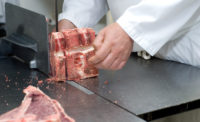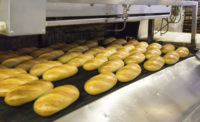High demand for packaged foods and processed meat products, increased concerns for food safety, technological advancements in the food processing industry and aggrandized need for automated processing systems are expected to drive the growth of the global meat processing equipment market, according to a study released by Allied Market Research, Portland, Ore.
The report, "Meat Processing Equipment Market by Type (Cutting Equipment, Blending Equipment, Tenderizing Equipment, Filling Equipment, Dicing Equipment, Grinding Equipment, Smoking Equipment, Massaging Equipment, and Others), Meat (Processed Beef, Processed Pork, Processed Mutton, and Others), and Application (Fresh Processed Meat, Raw Cooked Meat, Precooked Meat, Raw Fermented Sausages, Cured Meat, Dried Meat, and Others): Global Opportunity Analysis and Industry Forecast, 2018-2025,” estimates the global meat processing equipment market to reach $18.82 billion by 2025, registering a CAGR of 6.9% from 2018-2025.
The growth of the meat processing equipment market is driven by high consumption of processed and packaged foods due to surge in working women population, rise in disposable income and change in dietary habits. Moreover, technological advancements in meat processing equipment such as built-in sensors continue to boost market growth.
However, rising cost of raw materials used for manufacturing processing equipment and stringent laws regarding consumption of certain types of meat in some countries would hamper the growth of the market. Conversely, increasing focus on attractive packaging materials and expanding footprint in Vietnam, China, Bangladesh and Brazil would provide lucrative opportunities to the market players in future.
The cutting equipment segment accounted for 21.6% of the total market revenue in 2017, and is projected to retain its lead through 2025. Moreover, it is expected to grow at the fastest CAGR of 8.1% from 2018-2025, as cutting equipment is used to separate essential meat and fat portions from rest of the carcass. The report also analyzes blending equipment, filling equipment, tenderizing equipment, dicing equipment, grinding equipment, smoking equipment, massaging equipment and more.
Among meat types, the processed pork segment captured the highest market share of 29.9% in 2017, and is expected to remain dominant through the study period. This is attributed to the rise in demand for processed pork products such as sausages and bacon worldwide. However, the processed beef segment is projected to grow at CAGR of 7.3% from 2018-2025 due to shift in dietary habits of consumers toward high-protein sources, especially beef. The study also analyzes processed mutton and others segments.
Among applications, fresh processed meat segment generated the largest share in 2017, accounting for 23.8% of the total revenue. It is projected to retain its lead through 2025, registering the highest CAGR of 7.7% through the forecast period. This is on account of the growing demand for fresh processed meat across developing countries due to rapid urbanization, high consumption of fast food among Millennials and extensive use of meat as a staple food in Western countries. Moreover, increasing use of fresh processed meat in sausages, burger patties and kebabs is expected to bolster market growth. The report also analyzes pre-cooked meat, raw cooked meat, cured meat, dry meat, raw fermented sausages and more.
The meat processing equipment market in North America contributed more than one-third of the total market revenue in 2017, and is anticipated to retain its dominance during the forecast period. This is because the United States is the largest producer and exporter of beef in the world, and is one of the significant adopters of beef and pork meat processing equipment. However, Asia-Pacific is projected to grow at the fastest CAGR of 8.5% from 2018-2025, owing to surge in population, rise in disposable income of consumers and rise in per capita consumption of meat in the region. The other regions analyzed in the study include Europe and LAMEA (Latin America, Middle East and Africa).






